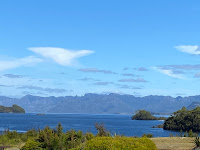In a place where an average 253 days of the year are overcast or raining, today’s clear blue skies were part revelation, part pure blind luck.
My day started a little earlier than Sue's.
 |
| Lake Pedder at sunrise |
I was up with sunrise and scantily clad owing to haste at getting down to Lake Pedder: if you can call a tracksuit scanty! The reward came with the views. Catching the lake still in its state of nighttime quiet and the sky in transition, even on the iPhone I was able to trap some of the mood. The mountains off to the south were taking potluck with the sun: some reflecting early rays, some still in their night shadow pyjamas. The lake was fairly still and dark and the mountains which photo-frame its existence to the east, danced a morning of silhouette and golden outline. The sun was up but hidden by their bulk.
One picture became another, each better than the preceding.
When I returned home, Sue was given a crumpet with a cup of tea to encourage her from bed and I finished yesterday's task by completing the folding of washed clothes.
From then until a late lunch, we wandered the two dams to our west, the Gordon River Dam and the Serpentine.
Lake Gordon is larger than Lake Pedder and exists to its north. Between them, they are the biggest pondage of water held in Australia, their 514 square kilometres being 31 times Sydney Harbour (goodness knows how many MCG's or Olympic swimming pools!) still above the dam but within walking distance.
 |
| Gordon River Dam |
Once on the wall, the whole experience becomes a matter of being staggered by scale. Standing in the middle of the obvious horizon curve, you also become aware of the vertical curve of the concrete wall. This double curve is the reason the great body of water behind you doesn't push on through. I couldn't help thinking about the opportunity offered by a Hobart company to step backwards off the wall at that point and abseil down the vacant curved face of the wall, 140 metres to the bottom. I love abseiling but I'm not sure I could take on the biggest commercial abseil in the world.
Then there are the caged ladders that descend in sections down the face. Who the hell uses them? Or the tracked and enclosed elevator platform that lowers down from above the wall, to the very bottom, to allow equipment and men to service the dam. Two cables bear the weight and responsibility for their safe passage.
Beyond the wall, the Gordon River flows benignly on. On the forward face, a great mass of black water gathers itself. Around the lake for near and far, deadly faces drop into the water with murderous intent and off in the distance, the tops of long dead trees are all that are left of greenery that once were giants but now are just navigation hazards. The water level looked to be half capacity.
As much as I admired the engineering and the science behind it, the deathly price to parts of the environment was a little too obvious.
From here, we stopped off at the power plant which uses this stored pondage to contribute to the 13% of Tasmania's electrical power created by hydro-electricity. There's not much to see as most of it is below the surface. A tower offshore and some heavy duty power lines are all that there is to see. One of Tassie Hydro's well placed information boards explained it all to us.
At Serpentine Dam, we found one of the three the culprits which caused the pondage that is Lake Pedder. The original Pedder was a delightful lake at the bottom of a glacial valley, where terminal moraine had caused the Serpentine and Huon Rivers to be dammed. Its 10 square kilometres had a pronounced pink sandy quartzite beach. It was untouched by humans and pure in its delivery of a unique environment for plants and animals.
 |
| Lake Pedder |
There still remains a push to drain Pedder 2 but the estimated cost will be up to $100 million to do the works and revegetate the area. It will never happen. Good cause, wrong decision.
Sue stamped on the wall of the Serpentine Dam in the only protest she felt open to her.
In the late afternoon, we went for a walk through what had been Strathgordon and now is Pedder Wilderness Lodge (our hosts). Strathgordon didn't exist before 1972. It was a prefab village created for workers building the dams and at its peak, 2,000 of them lived here with most conveniences (supermarket, entertainment etc). The buildings we are domiciled in were built later for those maintaining the dams but no longer needed because of automation. The prefabs are long gone, moved to other dam projects in Tasmania. At the last census, Strathgordon had a population of 15 permanent residents.
.jpg) |
| Click here for today's photos |
Every day in Tasmania just seems able to up the wow ante.
No comments:
Post a Comment
All comments will be moderated before being posted.